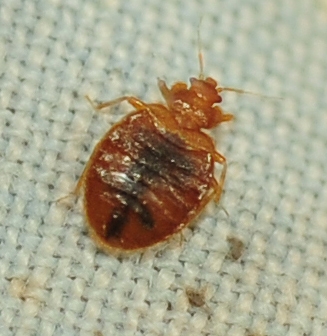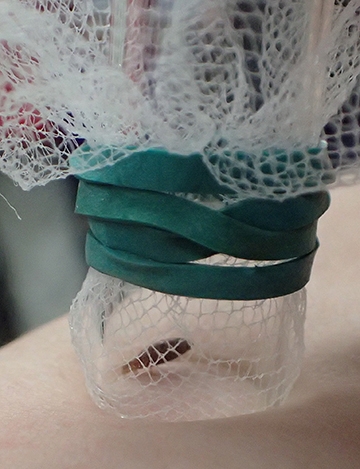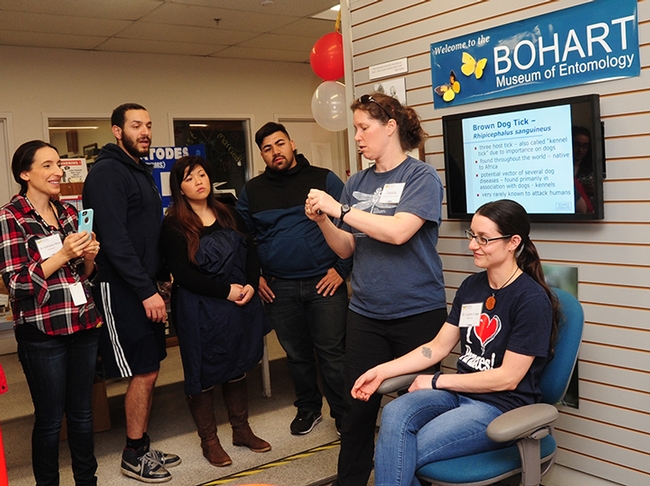
If you're rearing a bed bug colony, they need blood. Yours, if you don't mind.
Someone else's, if there's no one else around.
A big draw at the Bohart Museum of Entomology's recent open house, "Parasite Palooza," was a bed-bug feeding demonstration, featuring bed bugs from a UC Davis-reared colony.
When it was feeding time for the parasitic insects, Cimex lectularius, two scientists stepped forth and offered their arms in the name of science.
Charlotte Herbert, who is studying for her doctorate in entomology, volunteered to be the first "blood donor." Next to step up was nematologist/parasitologist Lauren Camp, who received her doctorate last December at UC Davis.
The particulars: Tabatha Yang, education and outreach coordinator for the Bohart, handed each scientist a bed bug enclosed in fine netting. The netting proved fine enough to prevent escape, but large enough to allow feeding.
"We don't want any escapees," Yang said.

The insects originated from the parent colony of UC Davis entomology graduate Danielle Wishon, now a forensic investigator for the Sacramento Police Department. She began rearing them several years ago, intending to do research. Later she gave some of her bed bugs to UC Davis researcher Jenella Loye of the UC Davis Department of Entomology and Nematology, who in turn loaned some to the Bohart Museum for its "Parasitic Palooza: Botflies, Fleas and Mites, Oh, My."
Wishon says it's fairly easy to rear bed bugs. "If you want a fast growing colony, you can feed them once a week. When I was very actively feeding them, I chose to feed them once or twice a month so the colony didn't get too big too fast. I've gone as much as six months without feeding them, and they repopulated just fine. I started this colony several years back, but I would occasionally add individuals I find on mattresses discarded by UC Davis students during the great fall quarter move."
Wishon acknowledged that in the past, she 'sub-let' feeding responsibilities to forensic entomologist Bob Kimsey of the UC Davis Department of Entomology and Nematology faculty and to entomology student/Bohart associate Wade Spencer. "Hey, they offered!" she said.
Has Wishon ever encountered bed bugs in a hotel room?

According to the Center for Disease Control and Prevention (CDC): "Everyone is at risk for getting bed bugs when visiting an infected area. However, anyone who travels frequently and shares living and sleeping quarters where other people have previously slept has a higher risk of being bitten and or spreading a bed bug infestation."
"Bed bug infestations usually occur around or near the areas where people sleep," the CDC points out on its website. "These areas include apartments, shelters, rooming houses, hotels, cruise ships, buses, trains, and dorm rooms. They hide during the day in places such as seams of mattresses, box springs, bed frames, headboards, dresser tables, inside cracks or crevices, behind wallpaper, or any other clutter or objects around a bed. Bed bugs have been shown to be able to travel over 100 feet in a night but tend to live within 8 feet of where people sleep."
Bed bugs are not known to spread disease, according to the CDC. However, excessive scratching can "sometimes increase the chance of a secondary skin infection."
Wishon noted that some people experience a "pretty negative reaction to the saliva--flu-like symptoms if I remember correctly. That's really the reason I want to keep feeding a colony even though I am not going to be doing research on them anytime soon--most of the older researchers I know who once fed a colony but stopped, or who traveled to countries where they were common and were exposed regularly but then moved back, and were exposed to them many years later, seem to develop hyper sensitivity to bed bug saliva. This could be completely anecdotal and coincidental, but I've heard this familiar story enough times to want to error on the side of caution and continue feeding without years of breaking. I don't want to develop a negative reaction to exposure."
Both Camp and Herbert said they basically didn't feel much of anything when the bed bugs began feeding. Here's why: "When bed bugs bite, they inject an anesthetic and an anticoagulant that prevents a person from realizing they are being bitten," according to the CDC. "Most people do not realize they have been bitten until bite marks appear anywhere from one to several days after the initial bite. The bite marks are similar to that of a mosquito or a flea -- a slightly swollen and red area that may itch and be irritating. The bite marks may be random or appear in a straight line. Other symptoms of bed bug bites include insomnia, anxiety, and skin problems that arise from profuse scratching of the bites."
Any reactions? "It took a while, but I did react to the bed bug bites," Camp said. "On the third day (Jan. 25), I saw raised red marks on my right arm, that were a bit itchy. Guess it took me three days to react."
Said Herbert: "I had a very small red mark where it bit, but no lasting marks or feelings. I felt it bite, but just barely. However, I have had bed bugs before while visiting my grandparents in the U.S. Virgin Islands and the bites were pretty terrible! I was itchy and thrashed all night, I didn't realize what was happening until the morning when I was covered in little bite marks and we found the bed bugs on the edges of the mattress. They looked very well fed!
No wonder folks say: "Good night! Sleep tight! And don't let the bed bugs bite."
Attached Images:

Nematologist/parasitologist Lauren Camp, who received her doctorate at UC Davis last December, volunteered for the bed bug-feeding demonstration. (Photo by Kathy Keatley Garvey)

Bohart Museum visitors crowd around Charlotte Herbert, a graduate student in entomology at UC Davis, as she participates in a bed bug-feeding demonstration. (Photo by Kathy Keatley Garvey)

Tabatha Yang (standing at right) explains what bed bug-feeding is all about. Seated is "blood donor" Lauren Camp. (Photo by Kathy Keatley Garvey)